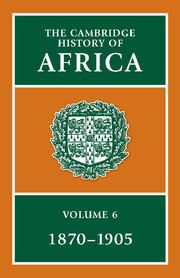Book contents
- Frontmatter
- Introduction
- 1 Africa on the Eve of Partition
- 2 The European Partition of Africa: Origins and Dynamics
- 3 North Africa
- 4 Western Africa, 1870–1886
- 5 Western Africa, 1886–1905
- 6 Western Equatorial Africa
- 7 Southern Africa, 1867–1886
- 8 Southern and Central Africa, 1886–1910
- 9 Portuguese Colonies and Madagascar
- 10 East Africa 1870–1905
- 11 The Nile Basin and the Eastern Horn, 1870–1908
- 12 The European Scramble and Conquest in African History
- Bibliographical Essays
- Bibliography
- Index
- Map 9 West Africa, c. 1870">
- Map 10 West Africa, c. 1905
- Map 13 The Congo Independent State
- Map 26 Ethiopia, the Nile Valley and the Horn in the era of Menelik II
Introduction
Published online by Cambridge University Press: 28 March 2008
- Frontmatter
- Introduction
- 1 Africa on the Eve of Partition
- 2 The European Partition of Africa: Origins and Dynamics
- 3 North Africa
- 4 Western Africa, 1870–1886
- 5 Western Africa, 1886–1905
- 6 Western Equatorial Africa
- 7 Southern Africa, 1867–1886
- 8 Southern and Central Africa, 1886–1910
- 9 Portuguese Colonies and Madagascar
- 10 East Africa 1870–1905
- 11 The Nile Basin and the Eastern Horn, 1870–1908
- 12 The European Scramble and Conquest in African History
- Bibliographical Essays
- Bibliography
- Index
- Map 9 West Africa, c. 1870">
- Map 10 West Africa, c. 1905
- Map 13 The Congo Independent State
- Map 26 Ethiopia, the Nile Valley and the Horn in the era of Menelik II
Summary
This volume deals with a period of about thirty-five years, from about 1870 till about 1905. This was, of course, the period which saw, first, the scramble by European powers and interests to stake out territorial claims in Africa, next, the paper partition of the continent by those powers, and finally the colonial conquest and occupation. In 1870, the only large areas to have suffered such inroads lay either to the north of the Sahara or else to the south of the Limpopo. By 1905, Ethiopia and Morocco were the only truly independent African states, and the innumerable petty polities of pre-colonial Africa, as well as a few larger ones, had been consolidated into the forty-odd colonies and protectorates which were destined to become, with only a few subsequent changes, the sovereign states of modern, post-colonial Africa.
Yet, to characterise the period wholly in this way, is to see it too much through European eyes. As the succeeding chapters show, African history throughout this period pursued paths still largely separate from those of the European colonisers. The treaty-making expeditions of a Binger or a Brazza, of a Johnston or a Lugard, of a Cardoso or a Serpa Pinto, were scarcely to be distinguished by any African observer from the trading caravans of the Dyula or the Hausa, of the Sudanese jallāba or the Swahili-Arabs, of the Mozambican Chikunda or the Angolan pombeiros. The diplomatic partition of the continent passed almost unnoticed by the Africans whose territory was at issue. The colonial conquest and occupation was experienced by them as a piecemeal phenomenon, which affected some of those living near the coasts as early as the 1870s and 1880s, but which reached most of the interior peoples only during the 1890s and the 1900s.
- Type
- Chapter
- Information
- The Cambridge History of Africa , pp. 1 - 9Publisher: Cambridge University PressPrint publication year: 1985
- 1
- Cited by

